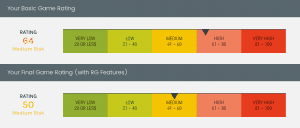
Gamgard 3.0 is the first ever tool to consider how certain responsible gaming (RG) features can reduce reduce the risk of specific games for vulnerable players. After reviewing the literature, a series of surveys were sent to 17 international experts in the field of responsible gaming research and problem gambling treatment. Each expert was asked the rate the extent to which they believed evidence supported the notion that various RG tools could diminish the risk for vulnerable players developing a gambling problem in relation to a range of ‘low-risk’, ‘medium-risk’ and ‘high-risk’ games. The final version of Gamgard 3.0 was then tested against a range of games to ensure that it correctly assigned risk according to the known risk associated with those game types (e.g., slot machines, weekly lottery draws, etc.) as reported by treatment provider reports.
The following RG features are considered by Gamgard version 3.0 as reducing the risk score of a game:
- Pop-up reminders of time spent playing a game
- Player-defined spend/loss/deposit limits (mandatory and voluntary to set)
- Player-defined time limits (mandatory and voluntary to set)
- Behavioural feedback tools (mandatory and voluntary to use & mandatory and voluntary warnings)
Scoring Changes
The overall scoring range of Gamgard has been doubled and this provides for a wider and more nuanced range of risk scores. The final risk categories have also been expanded from ‘low-risk, ‘medium-risk’ & ‘high-risk’ to ‘very low-risk’, ‘low-risk’, ‘medium-risk’, ‘high-risk’ & ‘very high-risk.’

Website Redesign
The Gamgard website has also been completely redesigned in order to make the tool more user-friendly and to present more usable information. For example, the final scores are now shown on a wheel diagram that indicates the proportion of risk that each risk factor contributes to the overall risk score of a game. This makes it easier to identify which risk factors should be considered for further evaluation.

